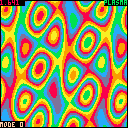Hello, this is my first attempt to code anything in this great virtual console.
It's just four effects I coded in my first few evenings since I bought the Pico-8.
I try to use the special modes at 0x5f2c to mirror some of the effects so that I have to draw less pixel.
Although, one can use the keys to go through all the modes, and based on the mode more or less pixels are drawn and the text are aligned accordingly.
A: changes mode
B: changes part





Hi, I am new to Pico-8 and I love it.
I yesterday tried to benchmark filling every pixel individually. At first I used pset. I tried something very simple like pset(x,y,c) where c = x + y + nframe, where nframe += 1 every update. I got 15fps, then I got 30 when I put it inside, like pset(x,y,x+y+nframe)
Then I tried to see if pset per pixel matters. I tried to poke at 0x6000, of course it's faster because I was poking two pixels at once. But if one needs to still control individual pixel, has to do bit manipulation with band and mul by 16, so it will be slow again. It would work for copying screen areas with memcpy, like a game I had seen that makes cool glitches.
Then I tried to make a buffer
vram = {}
for i=1,8192 do
vram[i] = fill with stuff..
end
but memcpy(0x6000,vram,8192) did nothing (black screen)
is there a symbol to get the pointer of vram? I also tried vram[0], vram[1] at the function.
Now if I copy some of the contents at 0x3400 and then do memcpy(0x6000,0x3400 it works, my array has stuff.











 5 comments
5 comments


